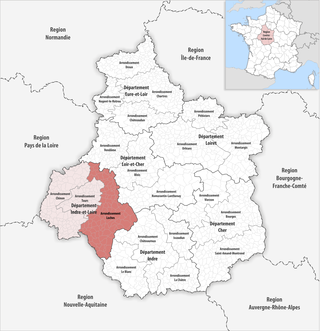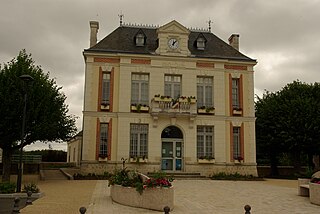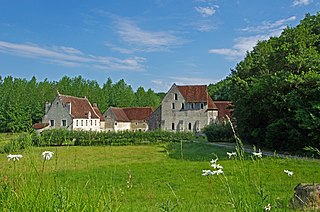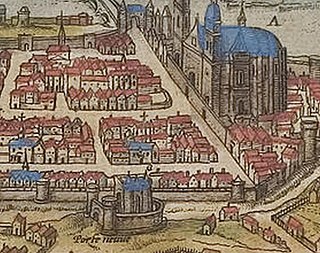
The arrondissement of Loches is an arrondissement of France in the Indre-et-Loire department in the Centre-Val de Loire region. It has 112 communes. Its population is 118,282 (2016), and its area is 2,742.5 km2 (1,058.9 sq mi).

James Intercisus, commonly known as Mor Yaqoub M’Pasqo Sahada, also called James the Mutilated or James the Persian, was a Persian Christian saint born in Ancient Iran. His Latin epithet, Intercisus, is derived from the word for "cut into pieces," which refers to the manner of his martyrdom. His death, along with the persecution of other Christians in the Sasanid Empire, started the Roman-Sassanid War (421-422).

Chambourg-sur-Indre is a commune in the department of Indre-et-Loire in the region of Centre-Val de Loire, France.

Cormery is a commune in the Indre-et-Loire department, Centre-Val de Loire. Its inhabitants are called Cormeriens, Cormeriennes.

Cadouin Abbey was a Cistercian monastery founded as a hermitage in 1115 by Gerald of Salles, in the name of Robert of Arbrissel, in what is now the commune of Le Buisson-de-Cadouin in the Dordogne, south-west France.

Charles de Grandmaison was a French archivist and historian.

La Corroirie is a fortified feudal stronghold belonging to the neighboring Chartreuse du Liget, located in the commune of Chemillé-sur-Indrois, in the Indre-et-Loire department, Centre-Val de Loire region.

The Louroux Priory, also known as Château du Louroux, is located in the commune of Louroux in the French department of Indre-et-Loire, Centre-Val de Loire region. It was founded in the 12th century by the Marmoutier Abbey. At the time, the Benedictine monastery was one of nine priories belonging to the Touraine abbacy and located in the Tours diocese.

The Arcis enclosure is an urban enclosure in the French commune of Tours in the Indre-et-Loire department.

The Abbey of Saint-Sauveur de Villeloin is a former Benedictine abbey located in Villeloin-Coulangé, in the French department of Indre-et-Loire. It was founded during the ninth century by two knights, Mainard and Mainerius. The abbey was destroyed by English troops in 1360 and again in 1412.

The Chapelle Sainte-Radegonde or Sainte-Radegonde Chapel is a underground structure, a former oratory converted into a chapel, on the slope of the Sainte-Radegonde hill, east of the historic town center of Chinon, in the French department of Indre-et-Loire in the Centre-Val de Loire region.

Beaugerais Abbey is a former Cistercian abbey, located in what is now the commune of Loché-sur-Indrois, in the Indre-et-Loire département of France.

The chapel of Saint-Jean du Liget, or chapelle Saint-Jean-du-Liget or chapelle du Liget, is an ancient chapel located in the commune of Sennevières, in the Indre-et-Loire department of France.
Anthony the Confessor was the archbishop of Thessalonica from 843 to his death. Most of his life is known through the vita of his relative Theodora of Thessalonica and he is venerated like her by the Eastern Orthodox Church on 2 November.

The Société archéologique de Touraine, founded in 1840 and recognized as a public utility in 1872, welcomes all those, amateurs or curious, students or professionals, who are interested in, work towards, or wish to contribute to the study, defense, and illustration of the history and heritage of Touraine.

The pillar of Yzeures-sur-Creuse is an ancient monumental column constructed from Jurassic limestone with shell inclusions. Some remnants were discovered in and near the foundations of the former church of the French commune of Yzeures-sur-Creuse, in Indre-et-Loire in 1895.

The castle site of Montbazon comprises a series of fortified structures situated within the French commune of Montbazon, located in the department of Indre-et-Loire and the Centre-Val de Loire region.

The Chapel of Saint-Libert was a former Romanesque church dated since the 12th century. It was situated within the historic core of Tours, France. Its construction was partially influenced by the Gallo-Roman castrum along the Loire River, with which it shares a portion of the original rampart. The church's nave has been included in the supplementary inventory of historical monuments since December 2, 1946, at the initiative of the Archaeological Society of Touraine (SAT).

The Châteliers oppidum is a French archaeological site located in Amboise, in the Indre-et-Loire department, in the Centre-Val de Loire region. The site is strategically situated on a limestone spur approximately 50 meters above the confluence of the Loire and one of its tributaries, the Amasse. It overlooks the modern city of Amboise, with the medieval Amboise castle situated at its end.



















